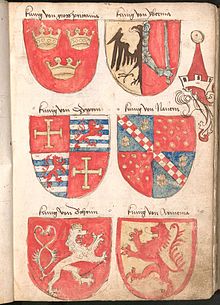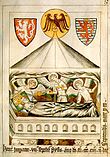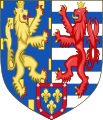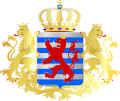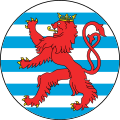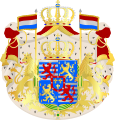Luxembourg coat of arms
| Luxembourg coat of arms | |
|---|---|

|
|
| Details |
The main features of Luxembourg's coat of arms originated in the 13th century. As with the flag of Luxembourg, the colors blue, silver and red are characteristic.
history
The history of the Luxembourg coat of arms, initially in a silver and blue field divided eight times, an upright striding red lion with a single tail, begins with Count Heinrich V of Luxembourg , son of Countess Ermesinde II of Namur-Luxembourg and Duke Walram IV of Limburg . Count Heinrich V founded the House of Luxembourg-Limburg under his new coat of arms, from which the coat of arms of the Duchy of Luxembourg, the family coat of arms of Elisabeth of Luxembourg , Queen of Bohemia and finally the current coat of arms of the Grand Duchy of Luxembourg emerged.
The origin of the coat of arms
The lion is a symbol of power and strength from the Bible. The red lion of the coat of arms of Luxembourg comes from the third crusade (1189–1192), as well as the red lion of the Duchy of Limburg, as well as other Dutch and German lions. After the death of Emperor Barbarossa , the father and grandfather of Count Heinrich V of Luxembourg, both Limburg knights, fought under the red soaring lion of Richard the Lionheart . Its coat of arms was the red lion of his county Poitou . Richard the Lionheart conquered the island of Cyprus on the third crusade and sold it to his feudal men of the Lusignan family from the county of Poitou, from whose house the King of Jerusalem was. The new coat of arms of the Kingdom of Cyprus became the red soaring lion of Richard the Lionheart on the old coat of arms of the Lusignan family, the four blue bars on a silver background.
Several knights brought this coat of arms with them from the third crusade and bequeathed it to their descendants. Count Heinrich V of Luxembourg received it from his father, who himself only wore the red lion without a stripe on the Limburg coat of arms. Other knights also brought the coat of arms of Cyprus with them, which resulted in double coats of arms. This is what happened with the Knights of Horst, whose red lion can be found on silver and blue stripes in today's Gelsenkirchen coat of arms . The knighted miller's son von Ried, whose coat of arms is painted in the coat of arms of Zurich, also brought a coat of arms with a red lion on silver-blue stripes, reminiscent of that of the Kingdom of Cyprus. The same goes for the feudal lords of Wunstorf, whose coat of arms can be found in Ulrich Rösch's book of arms.
The crusaders since the second crusade (1147–1149) found it an honor to be allowed to carry the same shield as their ancestors among the first crusaders. Count Heinrich V of Luxembourg took part in the Seventh Crusade in 1270 with his coat of arms, which goes back to the Third Crusade (1189-1192). A contemporary image of the coat of arms does not exist, only depictions painted over a hundred years later.
The first coat of arms
The first image of the coat of arms of Luxembourg is that of Count Heinrich VI. von Luxemburg , the son of Heinrich V. He took part in the battle of Worringen with his brother Walram . Both left their lives there. The contemporary and town clerk of Antwerp, Jan van Boendale, drew this battle and also the coat of arms of Luxembourg in the Brabantsche Yeesten .
It shows a soaring red lion without a crown with a simple tail on blue and silver bars.
The first gold-armored red lion with a gold crown 1320
The son of the fallen Henry VI, Henry VII of Luxembourg , became King of Bohemia and Holy Roman Emperor. His coat of arms of the county of Luxembourg was painted in the Trier Codex Balduini (1320). It shows the soaring red, gold-armored, gold-tongued and gold-crowned lion on a field divided into twenty silver and blue. In contrast to the crowned lion, the ten blue bars, also known as "Knight's Streets", were not inherited in the succession, but they may show the power of Henry VII of Luxembourg.
His son, John the Blind , King of Bohemia, took over the red gold crowned lion, but not the many blue bars. His quartered coat of arms with the Bohemian lion and the Luxembourg lion can be seen in the "Wapenboek van Beyeren" (1400).
The first Luxembourg lion with a double tail 1470
The coat of arms with the first red, gold-crowned Luxembourg lion with a double tail is shown in Ulrich Rösch's book of coats of arms, the Haggenberg Codex from 1470. Elisabeth of Luxembourg, the daughter of the last emperor from the House of Luxembourg, Emperor Sigismund, married the Austrian Albrecht II of Habsburg , who succeeded her father Sigismund as Roman-German King and King of Bohemia. In Ulrich Rösch's book of arms, the two family trees of Elisabeth of Luxembourg and Albrecht of Austria are shown.
The old coat of arms of the Habsburgs was a red soaring lion with a single tail, which one should not confuse with the Luxembourg red soaring lion. Therefore, the red soaring Luxembourg lion of the Princess of Bohemia and later Queen of Bohemia got the double tail of the Lion of Bohemia.
A special form under Maximilian I von Habsburg 1477–82
The last heiress of Burgundy, Mary of Burgundy married the Habsburg Maximilian I of Austria , who administered Burgundy until their son Philip the Fair came of age (1482) . During his lifetime, Emperor Maximilian had the coat of arms of his possessions attached to the city gate of Vöcklabruck . Including the coat of arms of the duchy "Lutzenburg". The peculiarity is that the four blue bars run over the red lion, similar to the bastard bars that run diagonally over coats of arms. He testifies that he is not directly related to the House of Luxembourg and that Burgundy only rules as the guardian of his son.
The coat of arms under the Spanish Habsburgs (1506–1684)
A former hospice, the Hospice Saint-Jean, is located in the Luxembourg estate and is now the Museum of Nature. Its entrance from 1674 is crowned with three coats of arms, that of the Spanish Habsburgs, that of the Duchy of Luxembourg and that of the city's governor, Prince Chimay. The coat of arms of Luxembourg clearly shows only a simple lion's tail. It is underlaid with the Burgundy Cross, which later became the cross of the Spanish Netherlands.
The coat of arms under the Austrian Habsburgs (1714–1795)
Even later, when Luxembourg was under the rule of the Austrian Habsburgs (1714–1795), the Luxembourg lion always got the double tail if it should not be confused with the Habsburg red lion. In the Kunsthistorisches Museum Wien there is a tabard for the herald, king of the duchy of Luxembourg, from the late 17th century, on which the soaring red lion is armed with golden claws and a golden tongue, with a golden crown and a double tail on five blue bars on silver. In the same period, the coat of arms of the Duchy of Luxembourg was depicted in the emperor's coat of arms of Empress Maria Theresa (1765) with only a single lion's tail. The coat of arms of the Duchy of Luxembourg mostly continued to exist with a simple lion's tail until it was legally established in the 20th century.
The current coat of arms of the Grand Duke of Luxembourg, divided into four with the Nassau lion, corresponds to the coat of arms of Elisabeth of Luxembourg and Bohemia in relation to the "roude Léiw". The Grand Ducal Dynasty of Luxembourg, Luxembourg-Nassau , would like to tie in with the last ancestor of the imperial house of Luxembourg and testify to a new dynasty of Luxembourg.
Coat of arms of the Grand Dukes of Luxembourg
In 1890, the Nassau-Weilburg family ascended the Luxembourg throne.
Its first representative, Adolph I , used several coats of arms. Between 1890 and 1898, a small shield with the family coat of arms of the House of Nassau was placed on the old coat of arms of Luxembourg. In 1898 the coat of arms for the House of Nassau was redefined.
The small coat of arms was quartered with two images of the arms of the houses of Nassau and Luxembourg. (Heraldically expressed: four of Nassau and Luxembourg, a royal crown rests on the shield.) The middle coat of arms: Four of Nassau and Luxembourg, the shield held by two lions, on each of whose heads a royal crown rests, the whole thing framed by a purple cloak, on which also rests a royal crown.
The large coat of arms (here on the left) is as follows: main shield split three times and divided three times (which results in 16 spaces ); applied a heart shield, square from Nassau and Luxembourg:
|
|
Six helmets rest on the shield, a crown each on the 1st and 6th shield.
- Helmet Figures:
- Greyhound (neck and head, red-tongued with black collar, which is lined and banded with silver); from the coat of arms of Moers.
- Flight (divided silver and black); from the coat of arms of Saarbrücken.
- Sitting lion (gold, red tongued, red crown) between two blue buffalo horns studded with shingles; from the Nassau coat of arms.
- Flight (black), seeded with golden linden leaves; from the coat of arms of the old Luxembourgers (actually the crest of Bohemia).
- Flight (black, covered with red disk, in it two golden leopards); from the coat of arms of Diez.
- Pointed hood (gold with a curved tip) from the Sayn coat of arms.
- Shield holder: two crowned golden lions, red-tongued, with their heads turned away.
The shield and the shield holder on four entwined branches of gold, the whole thing on a purple cloak , trimmed with gold and bound, lined with ermine on the inside .
The royal crown rests on the cloak.
This coat of arms was carried by the princely family until the abdication of Grand Duchess Charlotte in 1964.
By marrying the Grand Duchess Charlotte , Prince Felix of Bourbon-Parma entered the Luxembourg nobility; it received its own coat of arms (unfortunately no picture available), and the house has been called Luxemburg-Nassau ever since .
Coat of arms of the Grand Duke Jean
There were several projects for the coat of arms of the Hereditary Prince Jean , which, however, were never carried out effectively because they were flawed, so that since he took office as Grand Duke in 1964 he only had the small coat of arms. Until then, Jean had had several variants of the coat of arms, sometimes giving priority to the Luxembourgish, sometimes the Nassau lion, and sometimes including the family coat of arms of his father, Prince Consort Felix of Bourbon-Parma , and sometimes omitting it.
Today's coat of arms and national emblems
By law of June 23, 1972, published in Mémorial 051 of August 16, 1972 and of July 27, 1993, which amends and complements the law of June 23, 1972 on national emblems (Mém. A-No73 of September 16, 1993 Page 1416), the coat of arms and emblems of the Grand Duchy that are valid today were introduced.
The coat of arms
The national emblems
Luxembourg cockade
The coat of arms of HRH Grand Duke Henri
Individual evidence
- ↑ MEMORIAL Official Journal of the Grand Duchy of Luxembourg, A-No51 of August 16, 1972, p. 1288 (PDF 135 KB; French)
- ↑ MEMORIAL Official Journal of the Grand Duchy of Luxembourg, A-No73 of September 16, 1993, p. 1416. (PDF 416 KB; French)
literature
- Armorial du pays de Luxembourg, Dr. Jean-Claude Loutsch, Publications nationales du Ministère des Arts et des Sciences, Luxembourg 1974
- Karl-Heinz Hesmer: Flags and coats of arms of the world. History and symbolism of the flags and coats of arms of all states. Bertelsmann Lexikon Verlag, Gütersloh 1992, ISBN 3-570-01082-1 .
Web links
- Flag lexicon (description of flag and coat of arms)
- [1] (digital book of arms by Ulrich Rösch)
- [2] (digital Werniger or heraldic book)
- [3] (digital Zurich coat of arms)
- [4] (Beyeren's book of arms)
